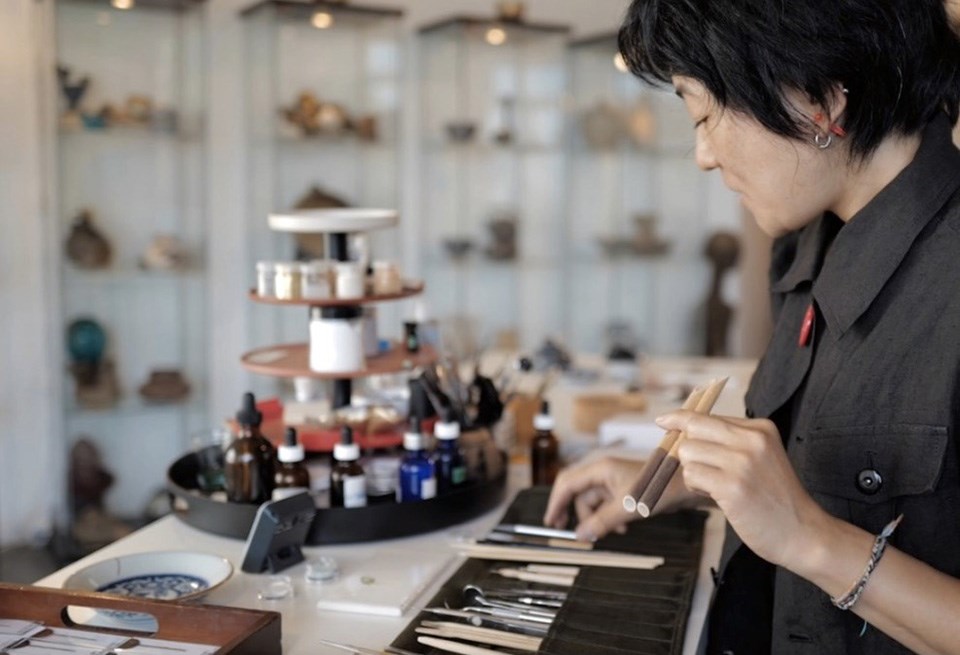Naoko Fukumaru’s relationship with kintsugi, the Japanese art of restoring damaged ceramics, began serendipitously, to say the least.
Before arriving in the qathet region with her family in 2018, Fukumaru worked as a professional ceramic and glass conservator at the Detroit Institute of Arts Museum, Metropolitan Museum of Art in New York, and other institutions in the USA, Europe, Egypt and Japan. She has collaborated on famous works such as The Last Supper by Leonard da Vinci, The Tomb of Tutankhamun in Egypt, Caravaggio and Veronese paintings and The Thinker by Auguste Rodin.
Although Fukumaru is a celebrated conservator, she took a break due to the lack of demand in her new rural home. So, she took on a support worker position working the graveyard shift supporting people living with physical and cognitive disabilities. All the while, she felt the tug of her beloved ceramic work.
It was at this job that she learned of local support for women and children fleeing domestic violence.
“I became friends with people in Powell River,” said Fukumaru. “They were very honest in telling me, ‘Naoko, your life is long, violence shouldn’t be in your life.’”
These friends helped her see that she and her children’s happiness is more important than keeping her family whole. So, after about a year, she left the support worker job and her 21-year marriage. At that time, Fukumaru said she was feeling depressed. The various changes in her life felt difficult to take on as a single parent, she added.
Then one day, she received an email from a local potter in Lund. It read something like: “I’m sorry I missed your Kintsugi workshop. I want you to put me down for the next one,” she said.
“I was like, what? I don’t know kintsugi. I never gave any workshop,” said Fukumaru. “But, I know kintsugi is from my culture, and I’ve been a conservator for 25 years. I am sure I can learn this. And I can give the workshop to this lady.”
So, Fukumaru ordered a book from Japan and studied kintsugi theory for six months. She ordered special lacquer and gold materials, and made her own tools using bamboo from her backyard.
Kintsugi is a 500-year-old art form using a special tree sap dusted with gold powder to highlight rather than hide cracks and edges during ceramic restoration. Not only is the practice used to repair an object, but through celebrating the object’s imperfections and impermanence, it enhances the item’s beauty and value.
“This taught me how to accept impermanence, imperfection, incompleteness of life,” said Fukumaru. “I realized my brokenness was healing through learning kintsugi.”
Beautiful mistake
The enquiring potter who sent the mistaken email happened to be from the Tidal Art Centre, so Fukumaru went to Lund and introduced herself.
“Thank you very much for your beautiful mistake,” she said. “Now I’m going to do kintsugi.”
Fukumaru did a nine-month art residency at the Tidal Art Centre, mastering the techniques. At the end of her residency, she gave workshops to that same local potter and other community members.
“So these people waited patiently for one year; they were amazed how their mistake became kind of true, and then, you know, I was rescued from their mistakes, from kintsugi,” said Fukumaru. “And now I am really feeling like kintsugi has a magical healing power. When I get ceramics from people, they are sad when they come in. ‘Oh, I broke my great grandmother's plate.’ But when I return with my kintsugi, they look at it and say, ‘oh wow, this is much more beautiful than before. I’m happy this plate got broken.’”
When she was doing European and Western restoration, she tried to hide the cracks and lines so no one could tell the item was ever broken. People were amazed at her ability to do that.
“No one said, ‘I’m happy this got broken,’ because we tried to hide all our mistakes and the brokenness.”
But through kintsugi, she heals the ceramics and herself. Now she would like to help others do the same.
Locally, Fukumaru is looking to work with domestic abuse survivors, like herself, using kintsugi philosophy and creating art together in a healing process. She plans to share these stories through an exhibition.
“I want people to know it’s okay to be broken,” she said. “But we can work together to heal and use that brokenness as a strength.”
In Vancouver, she is working with the YWCA and has several upcoming events, including an ongoing project teaching kintsugi with Yoko Ono.



